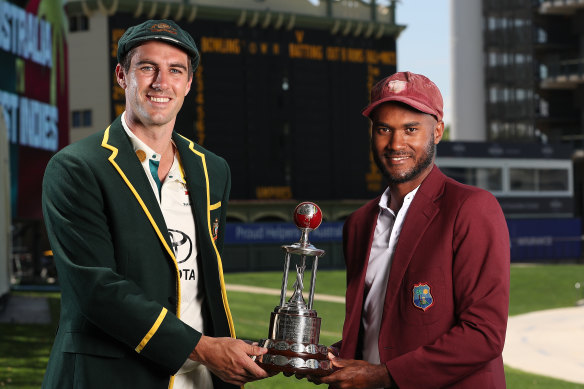- Exclusive
- Sport
- Cricket
- Test cricket
Global warning: Test cricket may shrink to six teams within four years
Test cricket may be played by as few as six countries within four years unless greater financial equalisation measures are taken by its richest boards – India, England and Australia.
This was among many conclusions from a summit of cricket’s great and good in the Lord’s Long Room, as Cricket Australia’s chair Mike Baird mixed with Indian Premier League owners, former top players, corporate leaders and officials from across the globe.

Australian Captain Pat Cummins with West Indies Captain Kraigg Brathwaite.Credit: Getty
Only the BCCI secretary Jay Shah was missing among notable figures at Cricket Connects, a summit put on by the Marylebone Cricket Club.
Those present included current ICC chair Greg Barclay, Rajasthan Royals owner Manoj Badale, Kolkata Knightriders owner Venky Mysore and former IPL chief Sundar Raman. Meeting under Chatham House rules, delegates were told that teams such as the West Indies were in serious danger of disappearing from Test cricket without more shared revenue.
“There was discussion around sharing economics and acknowledgement across the board that larger countries would potentially play a role in that,” Baird said. “But there were also questions around how many sustainable Test-playing nations are there?
“Do you have a smaller amount of Test playing nations that are sustainable, as opposed to trying to prop up a system with additional cost that is adding to the economic challenges of maintaining Test cricket.
“We don’t feel [Cricket Australia] should dictate to any country, but we’re open to ideas and proposals on how to support Test playing full stop. There’s a summer to fill, and white-ball cricket can play a role, but [Test cricket] still remains the dominant game in Australia. It is very clear Australia will support and invest and grow Test cricket opportunities as long as we possibly can.”
The current Future Tours Program, with a nine-team World Test Championship held every two years, runs until 2027. Australia has locked in tour agreements with India and England until 2031.
Baird argued that cricket needs to look at the example set by leagues such as America’s NFL, which has used equalisation measures between big and small markets while maintaining a tight competition with maximum jeopardy for teams, to be as successful as possible.
“There was discussion of the need to take meaningless content out of the schedule,” Baird said. “So content which is not attracting interest in terms of attendance at stadiums, viewership, without any sort of context for qualification [for World Cups], those games need to be seriously considered.

Travis Bazzana in action for the Beavers of Oregon State University.Credit: Getty
“If we can’t get to a position where that content has context and/or jeopardy, then we probably need to scale back some of those matches. That’s a decision that all countries have to look at and decide.”
Baird cited the loss of likely No.1 MLB draft pick Travis Bazzana from junior cricket in Sydney to a lucrative baseball career as a harbinger of the need to fight for talent on the ground.
The room of 100 delegates, featuring India’s Sourav Ganguly, South Africa’s Graeme Smith, former England captains Andrew Strauss and Mike Atherton and ex-Australian coach Justin Langer, also heard video pleas from current men’s captain Pat Cummins and former women’s skipper Meg Lanning to fix cricket’s unwieldy structure.
“Franchise cricket for some countries is more lucrative, more appealing than international cricket,” Cummins said. “If I went and played franchise cricket, I could probably be away for a half or a third of the amount we are for Australia.
“In Australia you know Test cricket is from November to January and basically no other cricket is going to get in the way of us playing Test cricket then. If we can have specific windows for IPL but then also Test windows, that makes the decision-making for the players a lot easier.”
Lanning, who retired from international cricket after a long struggle with mental health, stated that it was impossible for top players to do it all.
“The reality is in my view that you can’t be playing everything these days, both internationally and domestically as one of the top players,” she said. “I think it’s too much. And while it might seem fine initially and for a few years, I think it’s just inevitable that you’ll get burnt out doing that.”